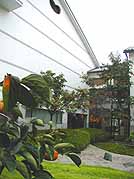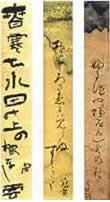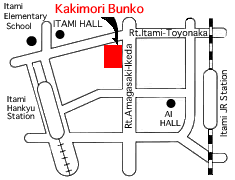Introduction

Kakimori* Bunko is a museum-library for the Kakimori Collection, one of the world's three** major collections of haiku poetry and painting. It was founded in November 1984. The collection itself was assembled by the late Professor Rihei Okada(1892-1982), an honorary citizen of Itami and authority on Japanese classical literature.
The museum-library is located at 2-chome Miyanomae, in the center of Itami. Occupying 851 square meters, it is designed to look like a Sake (Japanese rice wine) distillery. Close to Osaka and Kyoto, and famous for sake making, the city of Itami was financially and culturally a prosperous city during the Edo period (1603-1868). Many men of letters visited Itami, and left fine specimens of haiku poetry and painting,a number of which were preserved in the Okada family. Adding to his family's cultural inheritance, the late Professor Okada made a systematic collection of such materials.
Kakimori Bunko's mission is to contribute to Japanese culture and hand down Professor Okada's inheritance to future generations. The institution is dedicated to serve as a center of cultural activity and as a museum of haiku poetry and painting.
*“Kakimori,” in Japanese, means Gurdian of Persimmon Tree. Professor Okada, who assembled the collection, lived in an old house inherited from ancestors who for twenty-two generations had made sake. In his garden a persimmon tree which is over 350 years old is well known in Japan, because the famous poet, Rai San-yo once visited Itami, tasted fruit from the tree, and left a poem to honor the delicious persimmons.
** The other two are Shachiku-Chikurei Bunko, of Tokyo University, and Wataya Bunko, of Tenri Library.
The Kakimori Collection

The Kakimori Collection includes about 3500 books of haikai and haiku* and about 7500 original writings and paintings by Basho, Buson, Onitsura, and others. It covers four centuries of haiku history from medieval times to the modern day, including excellent examples by Rai San-yo and other men of letters who visited Itami. The collection is a unique and invaluable treasure of both Japanese art and literature.
Left - Hekigotou: Haru samushiverse (early spring)
Center - Onitsura: Omoshirosa verse (autumn)
Right - Basho: Furu-ike-ya verse (the famous frog and pond verse, spring)
*Haikai and haiku : Haikai is a linked verse which flourished in the late 17th century. The hokku (opening verse) of haikai is now called haiku. Haiku is a verse form based on seventeen syllables arranged in a five-seven-five syllabic pattern. As the world's shortest form of poetry, haiku usually includes a “season word,” or element suggesting one of the four seasons of the year. This feature is derived from Japanese life, which is traditionally related to nature in each season.
Information
Special Exhibitions
Special exhibitions are held twice a year. Lectures on the theme are scheduled during the special exhibitions.
Small Exhibitions
Small exhibitions drawn from the Kakimori Collection are planned about five times a year. Each exhibition, under its own theme, shows the history of Haikai and Haiku, including Teimon, Danrin, Basho, Buson, Issa and other modern poets after Shiki.
Education Programs
Kakimori Cultural College is open to all. Also other various seminars and lectures are given by the authorities.
Library and Study Room
The library houses books included in the Kakimori Collection, as well as dictionaries, encyclopedias, and research materials relating to Japanese literature and art. The Kakimori Collection's haiku materials are on microfilm. Visitors can read these by using a microfilm reader and make copies by means of printer for a service charge. If necessary, users may read the original book in the presence of a curator. A fee will be charged.
Membership Privileges
Kakimori Bunko members receive “Tomonokai News”, the annual bulletin, advance announcements of the museum program, discounts, and exhibition catalogues.
Other Functions
Researches
To carry out Professor Okada's last wishes, the curators may acquire, preserve and conduct research on haiku books and materials.
Publications Service
The catalogues of the special exhibitions, also reproductions and post cards are available at the Information Desk.
Museum Information and Directions

5-20, 2-chome Miyanomae, Itami, Hyogo, Japan 664-0895
Telephone: 072-782-0244
Fax: 072-781-9090
- Directions:
- 9 minutes on foot from Itami Hankyu Station or Itami JR Station.
- 2 minutes on foot from Itami Honmachi bus stop on the Amagasaki-Ikeda Hankyu Bus Line.
- Office Opening Hours:
- Open Tuesday-Sunday, 10:00am - 6:00pm.
- Closed all Mondays and December 29 - January3.
- When Monday falls on a national holiday, the museum is open on that day and closed on the following day.(The museum is occasionally closed to change some exhibits.)
- Admission:
- Adults ¥200
- High school and college students ¥150
- Elementary and junior-high school students ¥100